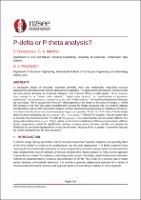P-delta or P-theta analysis?

Download
Date
2024-04-09Authors
MacRae, Gregory
Dehghanian, Seifollah
Moghadam, Abdolreza
Metadata
Show full item recordAbstract
Engineers have methods to estimating the displacements of inelastically responding structures in earthquakes. Rules to estimate such displacements for a structure with a certain period, damping, and hysteretic behaviour are available. When so-called “P-delta analysis” (also referred to as “second order analysis”, “higher order analysis”, or “consideration of geometric nonlinearity”) is considered, a range of displacements may be obtained depending on the height of the to the centre of weight, L. While this concept is not new, this paper illustrates this concept for simple structures with (i) dynamic stability considerations, and (ii) with time history analysis. It is shown that the lateral force in the hysteresis loop is decreased by “P x delta / L” or “P-theta” where L is the height to the centre of mass of a simple structure, and “theta” is equal to “delta/L”. As a result, “P-theta” analysis may be a better term to describe this phenomenon. Furthermore, consequences of this effect are shown for multistorey structures. It is shown that providing a net positive post-elastic stiffness, rnetk = [ r - P /(kL) ].k for each storey, where k and r are the initial stiffness and post-elastic stiffness factor respectively without considering P-delta, and P is the storey axial force, will result in a greater net positive post-elastic stiffness (and hence dynamic stability) for the system.
